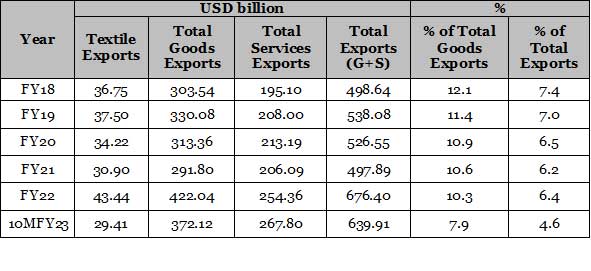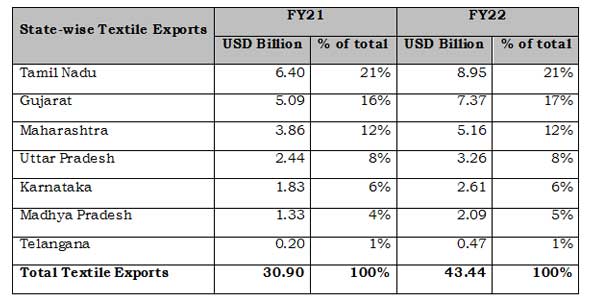
The Export Push
The recently unveiled Foreign Trade Policy (FTP) 2023 aims to increase India’s exports to $ 2 trillion by 2030. So, will FTP and PM Mitra parks help the Indian textile industry’s exports to reach $ 100 billion? Divya Shetty examines how well the industry is prepared for these schemes and what are their opinion on the new FTP.
The textile industry has witnessed major announcement in the last two months with the government announcing sites for setting up PM Mitra Park and continuity of Foreign Trade Policy (FTP). During 2022-23, India exported T&A products worth about $ 35.6 billion which is somewhat closer to the exports of $ 37.5 billion during 2018-19. During 2021-22, India exported T&A products worth $ 43.4 billion which was the highest-ever export of the Indian Textile and Apparel Industry. Looking at the boost, Piyush Goyal, Union Commerce and Textiles minister, announced that the India’s textiles sector aims will reach $ 100 billion exports by 2030.
The textile industry welcomed the new FTP as the Special Advance Authorisation Scheme has been extended to exports of the Apparel and Clothing sector.
Priyavrata Mafatlal, Vice Chairman, Arvind Mafatlal Group, applauds the government move by saying “The textile industry welcomes the new FTP for policy continuity and stability for a WTO-compatible policy as it paves the shift from an incentive-based regime to a remission and entitlement-based regime. The textile industry appreciates the continuation of the EPCG scheme and Special Advance Authorisation Scheme for the textiles and clothing industry as the industry is dependent on import of textile machinery as well as raw materials, especially speciality raw materials that are not manufactured in the country. The extension of the Special Advance Authorisation Scheme, which is extended to the export of apparel and clothing sector on a self-declaration basis was a long-awaited facilitation measure and will surely facilitate prompt execution of export orders.”
The FTP is applicable from April 1, 2023, and it does have any sunset clause. So it has no end date. Government will keep updating and amending it, as the need arise. Manjit Singh Saini, CEO & Technical Director, Paramount Instruments, is very optimistic with the New FTP as he states, “New FTP has focused on Ease of doing business by paperless regulations & rule based Automatic Approval system. Hence it will encourage and pave way for new garment and textile units to see the light of the day.” With FTP is also focusing on boosting new sector like e-commerce. Hence Indian garment exports can chalk our new ways of generating revenue through e-commerce.
While the previous FTPs were restricted for a limited period, the government has not mentioned any expiration details of this new FTP. Dr Siddhartha Rajagopal, Executive Director, TEXPROCIL, opines,“The government needs to be congratulated for introducing a dynamic policy – which will have no end date to be able to update it as and when required. The added features such as the new Amnesty scheme for one-time settlement of defaults in Export obligation by Advance and EPCG license holders will benefit the exporters. Also, revising the export performance threshold will ensure higher recognition and brand image for the Status Holders.” Raja Shanmugham, Former President, Tiruppur Exporters Association, also adds, “As the time bound FTA details are not specified, this will be an important factor to grow the trade.”
Apart from this, the new provision of Rupee Payment to be accepted under the FTP scheme, revamping of the e-Certificate of origin platform proposed – to provide for self-certification of CoOs as well as automatic approval of CoOs, will give a boost to the various trade agreements.

Figure 1: India’s textile exports from 2018-23.
Source: Ministry of Commerce
Shradha Saraogi Garg, Associate Director, India Ratings & Research, chalks down how the new FTP will help boost textile exports (See Figure );
- Perpetual continuance of duty remission schemes – duty drawback, RoSCTL and RoDTEP in line with the applicability of the policy unless amended shall ensure certainty of such benefits and help building more confidence in the players.
- Extension of special advance authorisation scheme to apparel and clothing allowing duty-free imports of inputs for manufacturing export items which will facilitate faster execution of export orders.
- Prime Minister Mega Integrated Textile Region and Apparel Parks (PM MITRA) scheme has been added as an additional scheme eligible to claim benefits under CSP (Common Service Provider) Scheme of Export Promotion Capital Goods Scheme (EPCG), which allows the import of capital goods at zero customs duty for production of export items. This shall reduce the capital cost for such parks.
- For e-commerce exports, the consignment-wise cap through courier has been raised from Rs 5 lakhs to Rs 10 lakhs.
- Reduction in the threshold of minimum exports required for the recognition of exporters as status holders so as to enable smaller exporters to avail of benefits that will reduce transaction costs.
- User charges and license fees have been reduced for MSMEs
- The amnesty scheme valid for a limited period up to 30 September, 2023, to address default on export obligations under EPCG
- Digitisation of e-Certificate of Origin and approvals and will reduce processing time and minimise physical interference
- Implementation of the Niryat Bandhu Scheme by DGFT for mentoring new/potential exporters on the intricacies of foreign trade
- Enhancement in partnerships with states for encouraging export promotion at the district level
- Four new export hubs have been announced, including two for textile segment expanding the total list to 43 such hubs having easier access to financial resources for expanding the operations.
- Proposal to internationalise domestic currency shall facilitate global trade payments in India’s currency.
Every industry in the globe is adopting automation and Indian textile industry is no behind. T Rajkumar, Chairman, Confederation of Indian Textile Industry (CITI), feels that the new FTP will bring transformative change in the sector. He explains, “It will not be wrong to say that the new FTP will bring transformative changes in India’s trade by bringing greater trade facilitation through technology, automation, and continuous process re-engineering and will pave the way for India to take care of the various emerging global and economic challenges.”
While the new FTP is aimed at improving the total merchandise exports of India, the textile & apparel industry being an integral part of India’s economy will also get benefitted from the same. By improving the procedural issues in customs and logistics, Government has tried to reduce the logistics time and processing time from the present time of as long as one month to just one day and this is going to act as a game changer for Textile Industry as in present in the era of “Fast Fashion” success of any exporting T&A nation depend on the logistics time.
“Recently the Government has signed a number of trade agreements and several others are in pipeline. This FTP has provisioned a number of policy measures such as the new provision of Rupee Payment to be accepted under the FTP scheme, revamping of the e-Certificate of origin platform proposed – to provide for self-certification of CoOs as well as automatic approval of CoOs, which will give a boost to the various trade agreements,” adds Rajkumar.
Ketan Pishe, Partners, P N RAO, informs, “FTP will help us a lot in import by helping become more on par with international markets. Until now, huge some of money for the import of fabrics, raw materials and machineries. The new FTA will also benefit and can sell our products in better costs, not only in domestic market but also internationally. Free Trade Agreement will help us when our input costs are down.
N Chandran, Chairman, Eastman Exports, comments, “India to be ready for new global and economic challenges. various other initiatives such as reduction in user charges for MSMEs under AA and EPCG, paperless filing of export obligation discharge applications, capacity building at the district level, infrastructure and logistics development intervention, facilitation for e-commerce exports will help in increasing the industry’s demand.”
Challenges to address
While the textile industry is ecstatic with the new FTP, there are a few shortcomings that the government need to address as per the experts.
Industry hails selection of ‘PM Mitra Parks’
On March 17, the Government of India announced the sites for setting up of 7 PM Mega Integrated Textile Regions and Apparel (PM MITRA) Parks for the Textile industry. These Mega Parks will feature world class infrastructure and “plug & play” facilities that will help to reduce production delays and reduce the cost of manufacturing thereby making exports of Indian textiles immensely competitive.
The selection of sites happened on a challenge method with parameters e.g. good connectivity, adequate quality power infrastructure, water and waste water disposal system, Industry Friendly labour laws, Single Window Clearances, Stable and Conducive industrial/textile policy of the state (see Figure 2). The State Governments were requested to submit their proposals for setting up of PM MITRA Park. And based on that, 7 states were picked for setting up the parks.
The 7 sites chosen by the Government are the best fit for a Textile Park as all these sites not only have excellent connectivity, infrastructure, utility services, etc. but favourable textile/industrial policies further add up to their selection.
Trade and Industry has expressed its heartfelt gratitude to the Prime Minister Narendra Modi for his far-sighted vision to integrate the 5 F’s of the textile sector viz. Farm to Fibre to Factory to Fashion to Foreign within the walls of the PM MITRA parks. “In my view, the parks will strengthen the foundations of “Atmanirbhar Bharat” making India a strong and dynamic player in global trade in Textiles and Clothing and serve as a catalyst in achieving the export target of $ 100 Billion by 2030,” says Rajagopal.
Dr Rajagopal states that TEXPROCIL has urged the government to enhance the time period for availing pre and post-shipment credit to exporters, remove import duty on raw cotton and reinstate interest equalisation scheme to original levels of 3 per cent for 410 items. The Council has also reiterated the demand to increase RoDTEP rates for certain categories of made-up products (Home Textiles) falling under Chapter 94.
Shanmugham suggests that the EPCG & Advanced licensing for the import of capital goods the obligation fulfillment of the players in the clusters like Tiruppur need to be modified.
He explains, “Since 2015 there is an ambiguity in this our plea is that all incremental exports over and above the base three year average values of an entity need to be allowed to get leveraged to the supporting players of that related field. The reason being the small micro investor can only be a facilitator to the exporter not been exporter himself. Hence the incremental exports advantage needs to be leveraged to the investor to boost his morale and help him to grow in his field. Now after so many representations it has been partially accepted on a CSP(Common Service Provider) mode in which also it has been limited to the cost of service only. In this method again, the investor could not fulfill his obligations in the given time which has not been understood.”
Chandran asserts, “I believe the policy is forward looking and dynamic. The only apprehension could be on the absence of a sunset clause. I think it is a good move and the government would want to evolve it with time and other factors.”
Saini tells, achieving this target of $ 2 trillion will require a coordinated effort from the government, the private sector, and other stakeholders. “It will also require addressing various challenges such as increasing productivity thru adoption of new technologies, improving the quality of products, enhancing productivity, compliance responsibilities in regard to environment & sustainability and accessing new markets. Overall, this policy is a welcome move for textile Industry and all other sectors and has the potential to transform India’s economy, create lot of employment opportunities, and improving the standard of living of its citizens.”
According to Saini, the PM Mitra Park will benefit the industry in many ways;
- The Integrated Mega Textile Park which the whole ecosystem is there this will reduce the logistics cost.
- These mega textile parks will boost the textiles in line with 5F vision: Farm to fibre, to factory, to fashion, to foreign vision.
- Theses parks with an Investment outlay of Rs 70,000 crore can generate massive employment to the tune of more than 20 lakh people.
- These advanced parks will further attract FDI (Foreign direct Investment, 100 per cent is now allowed) due to the immense benefits they will be provide to textile industry of India.
- The widespread facilities and comprehensive resources in the integrated textile parks will make Indian textile exports very competitive in the global markets. If we can focus on the quality, along with increasing quantities, keeping export time frames in the spotlight, there will be no looking back for a sparkling future of Indian textile industry.
The setting-up of Mega Integrated Textile & Apparel Regions should create an eco-system to boost growth of the textile industry, especially exports. “The textile industry in the country has been unorganised. This increased wastage and logistical costs impacted the competitiveness of the country’s textile sector. This cluster-based approach, a vision of the Prime Minister, will solve several problems of the sector. The PM MITRA Parks scheme is indeed a unique model that involves collaboration between the central and state governments in a bid to strengthen investment, promote innovation, generate employment, and ultimately transform India into a significant hub for textile production and exports,” expresses Mafatlal.

Figure 2: State wise textile exports of 7 sites on 2021-22
Source: Directorate General of Commercial Intelligence and Statistics
As Karnataka is one of the sites Bengaluru based PN RAO’s Partner, Naveen Pishe shares, “If statistics are to go by, Karnataka is the second largest textile employer in India. With the state being one of the 7 states for PM Mitra Park, it is a reinforcement of Karnataka’s position in the textile industry. The setting up of the textile park in Karnataka (Kalaburagi in specific), will significantly boost textile production and also pave the way for direct employment to over a lakh of people in the state. The mega textile park will contribute to the development of ancillary industries, infrastructure while also fuelling exports putting Karnataka on the global map in the textile industry.”
Chandran, who hails from Tamil Nadu, applauded the government’s move by saying, “I think it is a huge step to the boost textile sector. TN, especially, houses the entire textile value chain and the textile park will help the sector streamline the processes, which in turn will increase efficiency, resolve logistics issues and reduce the turnaround time. Also, knowledge transfer and exchange is something that will help smaller companies a great deal and help them grow. Job creation is another most important aspect to look forward to.”
Indian textile Industry is highly fragmented in nature and the cost of logistics in transporting textile raw material from one state to other has a considerable share in the overall cost of production. However, these parks will offer an excellent opportunity to create an integrated textile value chain right from spinning, weaving, processing/dyeing, and printing to garment manufacturing at a single location thereby reducing logistics costs and will provide a big boost to the 5F vision of the Prime Minister of India – Farm to Fibre to Factory to Fashion to Foreign.
The path to $100 billion
Apart from the major breakthrough of PM mitra Park and revised FTP, the government is also taking various initiatives at ground level to reach the target of $ 100 billion by 2030. Amongst them, the inclusion of 4 new districts of Export Excellence for Apparel and Handi-crafts products will surely enhance the export potential of these clusters which have proven competitiveness in the manufacturing of these products. Moreover, various initiatives such as the reduction in user charges for MSMEs under AA and EPCG, paperless filing of export obligation discharge applications, capacity building at the district level, infrastructure and logistics development intervention, facilitation for E-Commerce exports are taking care of the industry’s demand.
Upon recommendation of the Textile Advisory Group (TAG) and to curb the cotton price speculation through MCX cotton contracts Government has reconstitutes the Product Advisory Committee of MCX with more representation from the industry. After a number of review meetings of the newly constituted committee, MCX has revised the specification of its cotton contracts and the same was re-launched on Feb 13, 2023.
These scheme aims at promoting not just textile manufacturers, but the entire textile value chain from farm to fashion. Through this scheme, they will come on a common platform to engage and innovate. The project will not just create an enhanced infrastructure for textile promotion, but also create thousands of jobs.




